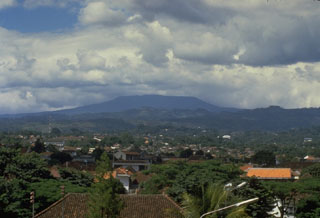Report on Tangkuban Parahu (Indonesia) — 5 September-11 September 2012
Smithsonian Institution / US Geological Survey
Weekly Volcanic Activity Report, 5 September-11 September 2012
Managing Editor: Sally Sennert.
Please cite this report as:
Global Volcanism Program, 2012. Report on Tangkuban Parahu (Indonesia) (Sennert, S, ed.). Weekly Volcanic Activity Report, 5 September-11 September 2012. Smithsonian Institution and US Geological Survey.
Tangkuban Parahu
Indonesia
6.77°S, 107.6°E; summit elev. 2084 m
All times are local (unless otherwise noted)
CVGHM reported that seismicity at Tangkubanparahu had increased significantly on 13 August, then again on 23 August; seismicity fluctuated and remained elevated through 6 September. Earthquakes were located 0.5-4 km beneath Ratu Crater and in an area W at depths of 4-12 km. Soil temperatures at Ratu Crater showed an increasing trend on 31 August, but had gradually declined by 5 September. Sulfur dioxide gas emissions were high in an area NW of the crater, causing CVGHM to remind visitors not to approach the crater within a 1.5-km radius. Based on seismicity, visual observations, gas measurements, and crater lake water temperatures through 7 September, the Alert Level remained at 2 (on a scale of 1-4).
Geological Summary. Gunung Tangkuban Parahu is a broad stratovolcano overlooking Indonesia's former capital city of Bandung. The volcano was constructed within the 6 x 8 km Pleistocene Sunda caldera, which formed about 190,000 years ago. The volcano's low profile is the subject of legends referring to the mountain of the "upturned boat." The Sunda caldera rim forms a prominent ridge on the western side; elsewhere the rim is largely buried by deposits of the current volcano. The dominantly small phreatic eruptions recorded since the 19th century have originated from several nested craters within an elliptical 1 x 1.5 km summit depression.
Source: Pusat Vulkanologi dan Mitigasi Bencana Geologi (PVMBG, also known as CVGHM)

